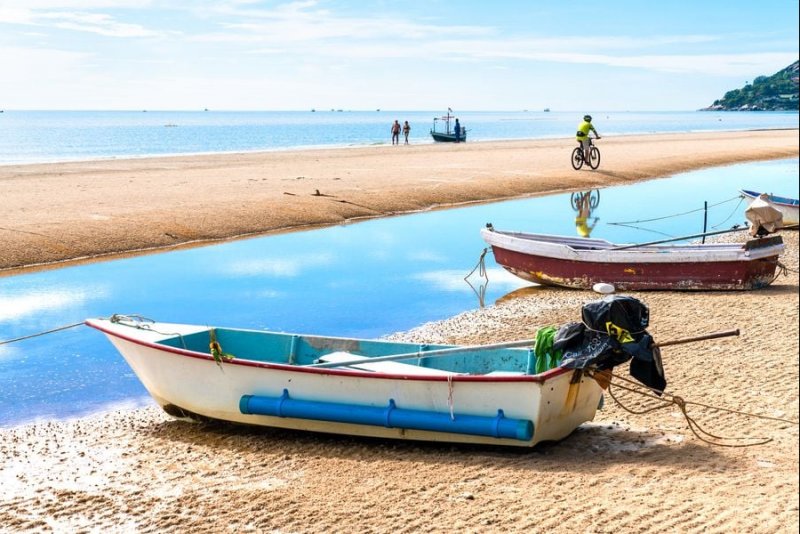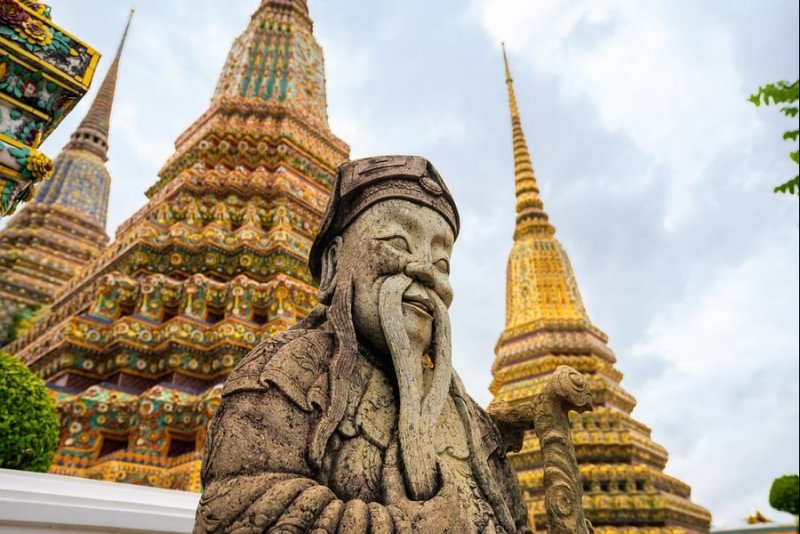Wow. That was the only word I could think of standing inside one of Hua Hin’s best natural attractions.
Not only because of the jaw-dropping beauty but because until recently, I had never heard of this place.
And I’m quite sure if I took a survey, the average traveller couldn’t pick out Hua Hin on a map either. I’m hoping to change that.
When you can hear waves gently lapping at your feet, against a backdrop of tropical rainforests and rugged mountains in the distance, it’s easy to forget that Hua Hin is only a three-hour drive from Thailand’s chaotic capital city, Bangkok. Of course, it’s got shopping, food and luxury. But now I’m going to focus on how to access my favourite 3 natural attractions in Hua Hin.
Get your “travel planning” cap on, and let’s go!

Phraya Nakhon Cave
If you visit Hua Hin and only experience one thing, this must be it. The Phraya Nakhon Cave is located within the Khao Sam Roi Yot National Park, about an hour’s drive south from Hua Hin. Entry to the national park is 200 baht per person and you could easily spend a day in the park exploring caves, climbing mountains, relaxing on beaches, and taking in the dazzling views.
We hired a taxi driver for the day for 2000 baht. You probably could find cheaper haggling a bit harder. Ours was booked via the hotel we were staying at.
When we arrived at Bang Po Beach (20 baht parking fee), our taxi driver gave us the very helpful hint to catch a boat from the carpark to Laem Sala Beach (it’s the only way to get there). This advice saved us a 2km hike up a very steep and slippery mountain - that’s in addition to climbing the 430m of slick steps to reach the cave. Boat tickets were 200 baht per person and were brought near the national park ticket office by rather unofficial-looking vendors. These friendly folks handed out numbered tokens that matched one of the many numbered longboats waiting near the shore. We walked down to the beach, out to our boat and climbed aboard. We had to wade until the water reached thigh-level so be sure to wear shorts and be mindful of any un-waterproof electronic devices in your pockets.

Tip: If you feel compelled to take the full 2km walk yourself, bring at least 1L of water per person – preferably more.
After a pleasant 10-minute ride, the boat dropped us around the cape in shallow water, just a few meters offshore, at Laem Sala Beach. A few metres inland we found a low bench with taps to wash the sand off our feet before following the signs to commence the hike towards Phraya Nakhon Cave. The climb to the cave was steep, but very beautiful with shady trees lining the rocky steps. Good sneakers are essential. The sights only became more stunning as we got close to the destination, with “flowstone” formations near the large cavern entrance. I recommend holding onto the railing at this point. I’m usually as sturdy as a mountain goat, but still slipped a couple times.


The view from within the entrance cavern was so beautiful that we thought this was the main attraction. I got quite the surprise stumbling across a small wooden sign pointing to the main cave.
I aimed to reach the cave mid-morning when the sun rays would stream through the open cavern roof and was not disappointed by the awaiting light show. In every direction, beautifully lit contrasts of rough white and yellow limestone glimmered against green foliage and moss. It was a photographer’s dream.

The central focus, Khuha Kharuehat Pavilion, was built in 1890 for the visit of King Chulalongkorn (Rama V). Since then Thailand’s subsequent kings have visited the site and it’s become well known to locals.



We spent a good hour slowly exploring the cave, along a dusty ring path, before starting the hike back to the beach. If you’re smart enough to pack lunch, the cave would have been a perfect picnic spot. Otherwise there’s a restaurant on the beach that sells tasty Thai food. A classic Thai chicken and cashew dish with rice only set us back about 150 baht – pretty reasonable considering the remoteness and lack of other dining options.
When we were ready to head back to the car park, we took our boat token to the small kiosk on the beach (you can’t miss it, it’s the only building). A park staff member contacted the matching numbered boat via walkie talkie, and 5 minutes later our long boat pulled up.
Bueng Bua Wood Boardwalk
Our next stop was the Bueng Bua Nature Observation Centre, or Bueng Bua Wood Boardwalk, which is also within the Khao Sam Roi Yot National Park. If you see the cave and boardwalk on the same day, you can use the same national park entry ticket and save a few dollars, otherwise its 200 baht (40 baht for locals). Our taxi drove to the boardwalk which took about 55 minutes from the Bang Po Beach carpark.
The Bueng Bua Nature Observation Centre is a serene wetland covered with waterlilies and long reeds and contrasted against a steep mountain range. A series of wooden boardwalks and gazebos sit over the marsh, along which we strolled, watched birds and listened to the gentle splashes of frogs.



The boardwalks were a little too dangerous for the likes of a few tourists we passed, as some of the wooden planks have rotten away and about 25% of the boardwalk was closed for repairs at the time of our visit. I thought the boardwalk sections that were open were more than enough to explore, and while I had to watch my step over the occasional missing plank, the stunning scenery and peaceful atmosphere were definitely worth the visit. If you have young kids, I would recommend that you just don’t let them run too far ahead.
Monkey Mountain (Khao Takiab)
Arguably, the best views of Hua Hin can be found from the 272-metre-high Khao Takiab, or Monkey Mountain. Monkey Mountain receives its name from hundreds of resident macaque monkeys leaping from tree to tree, fighting amongst the rocks, and sunbaking on the stairs. Unfortunately, the monkeys here are not as friendly as you might hope. We were warned not to feed them and to be careful of our belongings as the monkeys are not afraid to snatch valuables straight from the hands of unsuspecting tourists.



Perched at the base of Monkey Mountain is an unmissable 20-meter-high golden Buddha statue, which might have you expecting to find a sacred site, similar to the many temple sites throughout Thailand. While there are a couple small temples, Buddha statues, and faithful worshippers, there are also run-down buildings, car wrecks, broken furniture, and unkept war monuments. It is a peculiar place of stark contrast, but it’s also a place with a spectacular view and well worth the hike up the mountain. One of the small temples is said to hold a tooth of Buddha.
Entry to the mountain was free, with a donation box near the golden statue.

The Bottom Line
There is no shortage of natural attractions around Hua Hin. And after our experiences, I’m quite sure we’ll be back for more in the future. If you liked this article, check out what else we got up to in Hua Hin.






























Reader Comments...
"I respond to every comment by direct private email. I look forward to your feedback" - Josh BenderExtremely go through this article. I have never seen such beautiful article. Learn many things from this about nature.
Write Your Comment
Please DO NOT include links, URLs or HTML in your comments - they will be automated deleted and you will waste your time.